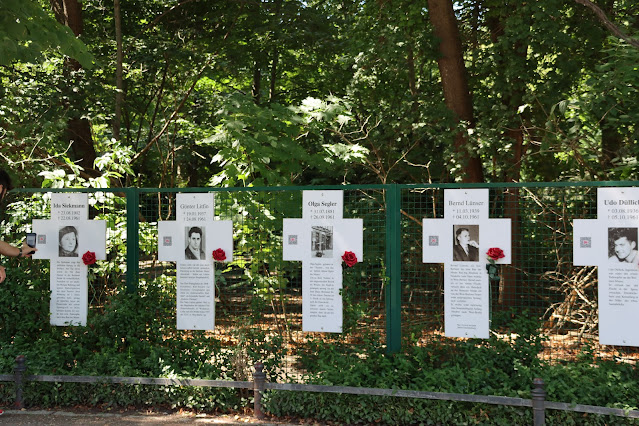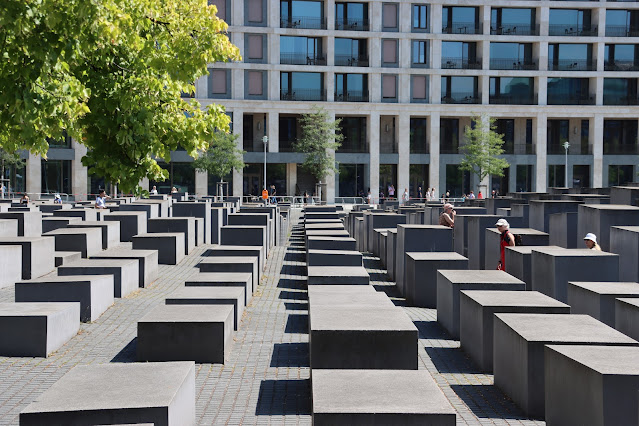Our final full day of holiday was spent in Berlin. We had been there before, many years ago but the boys wanted to check it out again.
We caught the train from just outside our apartment and started our day at the Reichstag (Imperial Assembly). The Reichstag is the seat of the German Bundestag (the lower of the two federal parliaments). The building was built in 1884 in Neo-Renaissance style and sits on the bank of the River Spree. The building was used as the Reichstag for Nazi Germany but a fire in 1933 forced them to move to the Kroll Opera House. It was a main target during the Battle of Berlin and there is a famous photo of Russian soldiers flying the Russian flag over the building in 1945.
 |
| A piece of wall outside the Reichstag from the Polish Gdask Shipyard - see below for more details |
 |
| From a distance with the dome visible |
Across the River Spree is the impressive Bibliothek des Deutschen Bundestages (Library of the German Bundestag):
Against the fence were some white crosses, we saw these throughout our trip in Berlin - they were a memorial to those killed trying to cross the Berlin Wall. Here are some, including some from the park just behind the Reichstag building:
Our next stop was the Brandenburg Gate. The gate was built in 1788 in the Neo-Classical style on the order of King Frederick William II of Prussia. It was built to replace an existing city gate on the road from Berlin to Brandenburg an der Havel.
Down the main road from the gate was the Siegessäule (Victory Column), built in 1864 to commemorate the Prussian victory over the Danes in the Second Schleswig War. During its building, Prussia also triumphed over Austria in the Austro-Prussian War (1866) and France in the Franco-Prussian War (1870) so these were incorporated into the column. We didn't head down that way, but got some photos from a distance.
Our next stop was the Denkmal für die ermordeten Juden Europas (Memorial to the Murdered Jews of Europe) or the Holocaust Memorial. This massive memorial is 1.9 hectares with 2,711 concrete slab arranged in a sloping square. The grand undulates and the height of the slabs varies from 0.2m to 4.7m tall. It was built 2003-2004.
Our next stop was a seemingly empty carpark:
This is believed to have been the site of Hitler's Führerbunker:
The Führerbunker was an air raid shelter and the last of the German Headquarters in World War II. Hitler moved there in January 1945 and at the end of the war, Hilter, his family and close advisors killed themselves rather than be captured. In order to prevent creating a rallying point for Neo-Nazis or Nazi sympathizers, the new government destroyed the Nazi landmarks, demolishing the bunker and burying it under rubble. The carpark was created and the location was kept secret. In 2006, the FIFA World Cup was to be held in Germany, so a sign post and schematic of the bunker was erected for history.
Moving on from the darker side of Berlin's history, we headed to the Massive Mall of Berlin, where we stopped and had lunch in the food court:
Just as we were about to leave, the boys noticed a big Lego store and asked to check it out. The prices were a bit cheaper than Sweden (so quite a bit cheaper than Australia), so Tomas spent his birthday money to buy a few sets - A spiderman mask and figure, and the giant Concorde set. We ended up lugging these around the rest of Berlin, but Tomas assembled the Concorde when we returned and it is an impressive set!
We then headed from one part of Berlin's history to the other - moving from the World War II memorials to the Cold War and Berlin Wall (Berlin Mauer).
At the end of World War II, Germany was captured by the western allies and the Russians. Germany was split into four parts, one each occupied by the United States, United Kingdom, France and Soviet Union. Berlin was split in four also, despite the fact the city actually existed within the Soviet Eastern Germany. As tensions increased between the Allies and the Soviets, the allied sections were combined into West Berlin (The Federal Republic of Germany (FRG)) and the Soviets retained East Berlin (German Democratic Republic (GDR)).
Eastern Germany was incorporated into the Soviet Bloc and run with a Soviet regime, while Western Germany was run by the allies and formed into the FRG. While conditions in the FRG improved, those in the Soviet GDR did not, and hunger and poverty became major issues. This caused a migration of citizens escaping from the Soviet East Berlin into West Berlin, particularly the well educated. In response to this, the Soviets blockades Berlin (as it was entirely in their territory), preventing food and supplies from arriving. The allies countered this with a massive airlift campaign.
In 1949 the GDR was formally declared and in the early 1950s the Soviets realised that they needed to stop the flow of people from East to West Berlin. A series of passes was established replacing the free travel between East and West Berlin and border defenses were increased, starting with a barbed-wire fence. By 1956 almost all travel to West Berlin was halted after a series of mass defections during 'visits'.
The construction of the Berlin Wall began in 1961 after the election of John F Kennedy who the Russian leader Nikita Khrushchev saw as young and weak. The border was closed on 12th August 1961 and in the morning the roads were torn up and barbed wire installed. The wall was built up from the initial barrier and patrolled with guards who had orders to shoot any potential defectors. The wall split neighborhoods and in some cases families and further isolated Western Berlin. The wall consisted of an outer strip against the Western side with a concrete wall with rounded top. This was followed by an anti-vehicle ditch a no-mans' land "Death Strip" of sand, then a guard road. There was then spikes or tank traps, an electrified fence with alarms then the inner wall and a restricted zone. The final iteration of the wall was known as "Stützwandelement UL 12.11" (retaining wall element UL 12.11) and was finished in 1980.
A series of border crossing points was established (and heavily defended). The most famous is known as Checkpoint Charlie, which allowed crossing by foot or car for foreigners or allied forces. It was named Charlie from the phonetic alphabet (Charlie being 'C'), the Soviets referred to it as Friedrichstraße Crossing Point (KPP Fridrikhshtrasse).
Over 5000 people successfully passed the wall to defect to West Berlin, but at least 140 deaths occurred, from guards shooting, jumping from buildings trying to clear the wall, or by drowning.
As sentiments against the wall continued to turn, many western musicians played concerts close to the wall, including David Bowie and Bruce Springsteen. Eventually the economic problems in the Soviet Bloc caused their grip over Berlin to loosen and in November 1989 Günter Schabowski, the party boss for East Berlin read a note on air stating that the regulations would be relaxed allowing private travel across the border after a delay to set it up. Schabowski didn't know all the details of the new plan and announced that he believed it took effect immediately. This was played over East and Western radio and proclaimed as a complete opening of borders - which was not the intention. This caused mass gatherings at the wall and the guards were overwhelmed and unsure what to do. Since no-one in East Germany took control or ordered a lethal response, the guards stepped down and the borders were opened.
 |
| Sign at Checkpoint Charlie |
 |
| Line marking where the wall stood |
 |
| Checkpoint Charlie |
 |
| A piece of the Berlin Wall, showing the rounded top |
We headed out to the Berlin Wall Memorial, which is a park that shows where the Berlin Wall had originally stood. The different paths and metal markers showed the location of various parts of the wall as I described above.
We also visited a site that houses some remnants from the wall:



Along the way between the Berlin Wall memories we made several other stops at important or interesting buildings. Here's a sample below:
 |
| The Bundesrat (Federal Council) building |
 |
| Mural |
 |
| Sculpture "Houseball" |
We stopped at the Neue Kirch (New Church), also known as the Deutscher Dom (German Cathedral). It was built in 1708 and reconstructed in 1988 after bombing in World War II.
From there we headed past the Konzerthaus (Concert Hall), built in 1821 and rebuilt in 1977 also after bombing damage.
Across the road from the German Cathedral was the Französische Friedrichstadtkirche (French Reformed Church of Friedrichstadt). The original church was built in 1701, but like most of the buildings in the area it was severely damaged in bombing and reconstructed in 1981:
Continuing along we passed the Equestrian statue of King Friedrich II. of Prussia:
We then came across the very impressive grounds of the Humboldt University of Berlin. Established in 1810 the buildings were impressive:
Also in the area was St Hedwig's Cathedral, built in 1747 and dedicated to Hewdig of Silesia. It was also damaged in the bombing and restored in the late 1950s. Next to it was the Berlin State Opera Building:
We also passed the German Historical Museum building:
And the Humboldt Forum Art Museum, including its reconstruction of the Sanchi-Tores (Gates of Sanchi) - a copy of the ancient Indian Gateway that once stood as the Eastern Gate of the Great Stupa of Sanci:
Our major stop here was Berliner Dom (Berlin Cathedral), a German Protestent Church, dynastic tomb of the House of Hohenzollern and the original castle chapel for Berlin Palace. The Cathedral was consecrated in 1454 as the Catholic St Erasmus Cathedral.
Behind the Cathedral was the Fernsehturm or the Berlin TV Tower, constructed in 1965 by the GDR to handle broadcasting but also to show on the Soviet power. It is 368.03m tall, making it the third tallest structure in the European Union:
Next stop was a series of old buildings near the river, starting with Handels-Ståtte Freidrichsstadt:
Then the Schlossbruecke (Palace Bridge), built in 1821 over the Spree Canal:
The Altes Museum:
The New Synagogue Berlin:
The Ehemaliges Kaiserliches Postfuhramt (Post House), built 1881:
I've taken a few liberties in the order of the sites we visited - we actually visited Checkpoint Charlie and then took this path to see these buildings aiming for the Cathedral. At this point we caught a tram out to the Berlin Wall Memorial. We then also checked out board game shop and caught the tram back to the Berlin Mall. We then walked to the Berlin Wall Remnants site. At this point it was getting late, so we walked back to the mall for dinner and then caught a train back to our hotel.
The next morning we had a 2.5hr drive to Rostock to catch our ferry in the early afternoon, so we headed out early and stopped for lunch and a quick visit to the border shop. The ferry trip was about 5 hours, but we had our own cabin, and we arrived in Trelleborg around 10pm. We were home and mostly unpacked by midnight when we finally crashed out in our own beds.
The trip was great fun, but we were exhausted by the end of it.











































































































No comments:
Post a Comment